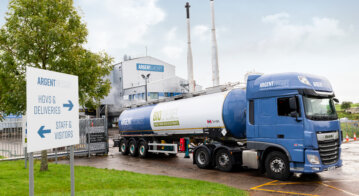RateLinx Drives Efficiencies and Savings with Data-Driven Logistics
Current consumer reliance on transportation and shipping is making many companies examine their internal processes and procedures. While technology clearly can be a game-changer for the logistics function, pre-pandemic it wasn’t the go-to place an objective observer would look when considering the most technologically-advanced part of the enterprise.
In fact, logistics is often seen as a cost center, leading to procurement processes concentrating on the lowest possible prices, putting quality of service as delivered to the company and its partners on the backburner.
Unfortunately, the global economy shows more consumers the best experiences as delivered by the leading vendors, stores, and service providers. The immediate comparison between the providers caught napping, and those offering personalized, smooth, and professional delivery mechanisms is glaringly obvious. As supply chains continue to weather the challenges and changes of the global pandemic, the logistics function is one of the most important areas of the company where technology is critical for scalability and provides an Amazon-like experience.
One company that’s committed to driving up standards along the supply chain and thereby boosting the quality of customer experiences is RateLinx. Like many of the solutions and platforms featured in the market, the core of the RateLinx offering is technology. However, unlike others in the logistics and supply chain technology space, it’s a company with more than 20 years of data-driven experience able to proactively leverage data to benefit customers.
We spoke recently to Jeff Dudzik, Global Vice President of Carrier Management at RateLinx, about changing a business’s logistics function from a cost center to a data-driven intelligence center committed to providing real-time insights that benefit the entire company.
Jeff’s role is working directly with carriers, directing procurement projects on behalf of RateLinx customers, and driving the initial and ongoing conversations that ensure the best carrier works at the best price and provides the best service levels.
We initially asked Jeff if the impression given of businesses always hunting down lowest-cost logistics was correct. In some cases, he agreed: “We have customers that will select the lowest-cost provider, deciding to sacrifice service for cost because maybe [they’re moving] something that doesn’t have a lot of inventory value to hold on the books. But in many cases, it’s the opposite—[many] RateLinx customers are service driven.” Jeff oversees the procurement process, and it’s here where the nuances are teased out.
It’s not always the case a company is seeking low-cost carriers but is looking for a better service. Dudzik elaborates: “If I’m taking a shipment direct from a location out to a customer, I’m going to be very service-driven: service is going to feed into my customer, depending on what business model I’m in. If I have inventory bouncing from a manufacturing facility to a distribution center to go into available stock for distribution, and I’ve got three or four days built into that, or even weeks, [then] speed of service doesn’t necessarily play the largest role in that space.”
The relationship with the carrier is defined by balancing quality service and the understanding of what carriers fit into that specific area of the supply chain. The relationship is what makes your business more effective. Relationship management is where RateLinx’s experience in the industry is most effective (Jeff is typical at RateLinx in that he’s an industry-hardened logistics professional, not a pure-play technology specialist). Jeff says, “The data from the ongoing relationships and all business partnerships along the supply chain are the sources of information that allow the logistics function to pivot from a cost center to a strategic player in an organization.”
“The biggest thing that we pride ourselves on is real-time, quality data. Our customers know cost and performance with precise, granular detail because of our carrier connections, data quality, and integration capabilities. Once we get data in, we enable our new cutting edge ‘Prescriptive InsightsSM‘—that is, easy-to-understand actions that digitize decision-making. Prescriptive technology powers confidence, proactivity, and automated actions.”

Source: Shutterstock
RateLinx’s Prescriptive InsightsSM empower shippers to make proactive improvements by quickly adjusting to changes, improving performance, reducing costs, and enhancing customer service. The system tracks anomalies within the data, and RateLinx creates dashboards for customers to see. “Our customers can see where freight costs or service spiked, and it sticks out like a sore thumb in the dashboards,” Dudzik says. “You understand in real-time, ‘Something’s going on in the network that I may not have had visibility into.’”
Data quality is a short-to-long-term win in most cases where technology’s ability to process information at scale is concerned—in or outside logistics. So, we asked Jeff what the quick wins were in most of RateLinx’s clients’ cases.
“In the past, in the case of product shortages […], what I’ve always seen is that data lags. It can lag up to 45 days from when a shipment was shipped to when an invoice comes in, to understanding the actual routing of a shipment,” Jeff says. “Possibly seven different alternatives may have cost less. Or a slower service model that still would have kept manufacturing or that customer in good standing. Not having data in real-time and complete spend visibility is driving decisions well after the fact.”
Jeff says this is a common scenario with many shippers. Only having visibility of freight spend after it’s paid, reactive decision-making, challenges in realizing cost-savings, and a never-ending data journey with continuous data quality gaps are issues most organizations can relate to. RateLinx’s data-quality approach brings solutions quickly to each of these challenges, with visibility to freight spend before it’s paid, the ability to make decisions proactively, the ability to realize cost-savings, and with a quick time-to-value.
Logistics is by no means the only part of the broader enterprise that benefits from insightful data analysis and real-time visibility. It might, however, be one of the last areas—an unfortunate tendency of the industry to which Jeff alluded. But the practical operational positives available from RateLinx’s solutions make logistics one of the most effective functions where companies can deploy technology.
To learn more about shipping, tracking, invoice management, applying data quality, and leveraging data insights, speak to a RateLinx expert or try a free analysis. The introduction of data-driven technology, correctly applied, can make the difference required to place logistics into a more strategic place around the boardroom table. With operational matters in hand, the image of logistics as a cost center is dispelled as the myth it should be.









